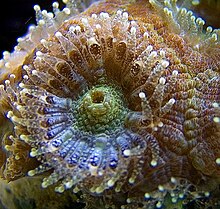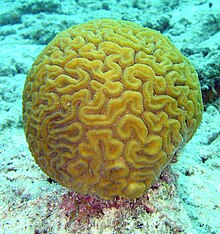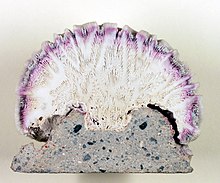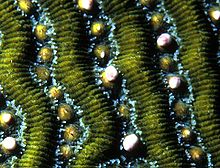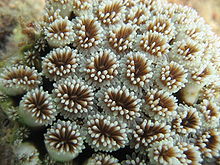Hard corals
| Hard corals | ||||||||||||
|---|---|---|---|---|---|---|---|---|---|---|---|---|
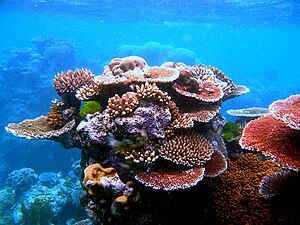
Hard corals in the Great Barrier Reef |
||||||||||||
| Systematics | ||||||||||||
|
||||||||||||
| Scientific name | ||||||||||||
| Scleractinia | ||||||||||||
| Bourne , 1900 |
Hard corals (Scleractinia, formerly Madreporaria) are animals that play the major part in the formation of coral reefs , the most biodiverse marine habitats on earth . The mostly tiny, sessile animals have the ability to deposit limestone at their base, thus forming reefs and, over the millennia, huge reef structures. Many islands, e.g. B. the Bahamas and Bermuda in the Atlantic , the Maldives in the Indian Ocean or Tuvalu and Kiribati in the Pacific were formed by the gradual growth of hard corals. A symbiosis with zooxanthellae , small, unicellular algae from the group of dinoflagellates , which are also important for the nutrition of the corals, helps most stony corals to form calcium .
All hard corals live in the ocean, most of them in the tropics . They are very simply built animals and, like jellyfish , belong to the cnidarians (Cnidaria) and in this to the six-rayed flower animals (Zoantharia). Their closest relatives are the sea anemones (Actiniaria) and other, lesser-known groups. They are only distantly related to the non-reef-forming soft corals (Alcyonacea), and only very distantly related to the reef-forming fire corals (Milleporidae).
distribution
The distribution of the reef-forming hard corals is influenced by the light requirements of the zooxanthellae. In addition, the water temperature should not fall below 20 ° C or exceed 29 ° C if possible. Stony corals therefore predominantly occur in shallow, light-flooded, tropical coastal waters. Their distribution area extends approximately to an area between 30 ° north and 30 ° south latitude . There are two main areas of distribution: the tropical Indo-Pacific , with the center in the island world of Indonesia , the Philippines and New Guinea , and the much less species-rich Caribbean .

There are also hard corals in temperate and cold seas and in the deep sea up to a depth of 6000 meters. In European seas, there are cold-water corals mainly on the coast of Norway and on the continental slope below 200 meters.
Hard corals need a salt content of at least 2.7% and are absent near estuaries and in brackish waters such as lagoons and tributaries. In addition, soft soils prevent their settlement and cloudy water hinders their growth.
features
Anatomy of the single polyp
Hard corals are mostly colonies of many thousands of individual polyps . Each polyp is a single animal and a single polyp is also at the onset of colony formation. As with all cnidarians, a stony coral polyp has a cup-shaped structure and is formed by two layers of cells, namely the outer skin, the ectoderm , and the endoderm , which surrounds the central gastric space . The mesogloea , which contains freely mobile cells and in which the nutrient transport takes place within the polyp body, lies between the two cell layers . The gastric space is divided by at least six mesenteries or septa (sarco septa) called partitions. This increases its inner surface. The gonads of the polyp are located on the mesenteries . The number and structure of the septa are important features of the hard coral system . The polyp digests its food in the gastric space. It communicates with the surrounding water through a central mouth and excretion opening. The mouth opening is surrounded by six or a multiple of six tentacles provided with nettle cells . The tentacles can be arranged in one or more rings.
The polyps sit in a corallite (coral calyx) made of aragonite , the structure of which reflects the internal anatomy of the polyp body and the septa in the form of sclerotic septa and is excreted by the polyp's foot disk. In many species, the sclerosis septa are connected by a ring wall called theca. In the center of the calyx there is usually a central column of lime (columella). Below the polyps there are old calyxes, which are separated by horizontal intermediate plates, the tabulae.
In most genera, the polyps are connected to one another by a tissue that covers the entire coral skeleton, the coenenchyma. So they can exchange nutrients and pass on stimuli. In some large polyp, colonial hard corals, such as Euphyllia paraancora , the connection between the polyps is lost as the colony grows, and the individual polyps sit close together at the ends of an otherwise dead skeleton.
The size of the single polyps is usually a few millimeters to one centimeter, but in the case of single stony corals they can become much larger. The polyp of Cynarina lacrymalis reaches a diameter of 35 centimeters when pumped up with water, the anemone mushroom coral ( Heliofungia actiniformis ) , which is confusingly similar to a large sea anemone , even reaches 50 centimeters, with tentacles of up to 25 centimeters in length.
Marine aquarists call the small polyps SPS corals (Small Poly Scleractinia) and the large polyps LPS corals (Large Poly Scleractinia).
growth
Corals grow by the polyps forming a new coralite on top of their old one. They also divide and the new single polyps form a new coral calyx. There is the extratentacular division in which the new polyp arises on the edge of the base of the parent polyp and immediately forms a new coralite. Another form is the intratentacular division, a form of division that begins within the tentacle rim. First, the mouth opening divides. The mouth sheath becomes wider and wider, with the two mouth openings moving apart. Finally, the wreath of tentacles also divides. As an intermediate stage, there is a polyp that has two mouth openings and two tentacle wreaths sitting close together. The division then continues from top to bottom, next covers the gastric space and is only complete when both polyps have formed their own coralites on the old common one.
Stony corals can have a wide variety of growth forms. Colony-forming corals can grow in the shape of branches, bushes, antlers, tables or crusts. Others resemble brains, mushrooms, tongues, or sea anemones. The last three growth forms are particularly common in solitary, i.e. H. non-colony-forming corals. Species with different growth habit can belong to the same family, species with a similar growth habit can belong to different families.
Calcification and symbiosis
A distinction is made between hermatype (reef-forming) hard corals, which is the majority, and ahermatype ( non -reef-forming) species. Hermatype stony corals excrete a calcareous skeleton on their feet, which consists of 98 to 99.7% calcium carbonate in the modification aragonite . They absorb calcium ions and hydrogen carbonate ions dissolved in seawater and precipitate calcium carbonate crystals from them. In the reaction per one produced water and carbon dioxide - molecule :
Since this is an equilibrium reaction, the process can also run in the opposite direction. The CO 2 dissolved in water , which also comes from the air or respiration of the coral polyps, reacts acidic and would dissolve the calcium carbonate again. The symbiosis with the zooxanthellae , unicellular algae that live in the skin of the coral polyps, helps in the corals living in shallow tropical water . The zooxanthellae carry out photosynthesis and use the carbon dioxide, which is converted into carbohydrates (sugar) together with oxygen . The nutrients formed also benefit the nutrition of the polyps. The coexistence of zooxanthellae and coral is a classic example of a mutualistic symbiosis , as both organisms involved have clear advantages. It is easier for the corals to precipitate lime in order to build up their calcareous skeleton and they are supplied with additional food, while the algae have a protected habitat in the body of the polyps. Hard corals that live with zooxanthellae ( zooxanthelate corals ) have a calcification rate ten times higher than hard corals without symbiotic algae ( azooxanthelate corals ). The acropores , which form a particularly porous, knotty limestone skeleton, grow in length by 16 to 25 centimeters per year. The mass of calcium carbonate formed annually by hard corals is said to be 900 million tons.
nutrition

Hermatypical, tropical hard corals get most of the nutrients they need from the zooxanthellae . They can survive for years in well-lit saltwater aquariums without any feeding, and they can also grow in the process. In nature, however, they catch tiny plankton organisms , mainly at night , which rise from greater depths at night. The polyps, which are often contracted during the day, then stretch out their tentacles covered with stinging cells . Stony corals that do not live in symbiosis with zooxanthellae, such as cold-water corals or species such as Tubastraea that live in dark caves and crevices, are completely dependent on foraging. In addition, corals can absorb organic substances dissolved in water directly through their skin.
Competition and aggression
Hard corals compete with other sessile creatures such as sponges and tunicates for space to grow. They compete for light with one another and with zooxanthellae soft corals, fire corals and algae. Rapid growth, such as the mostly branchy or bush-shaped acropores , enables these species to shade other, competing corals and cause them to die. Another form is direct aggression with the help of specially trained defense tentacles, which are formed from common feeding tentacles when they come into contact with another coral. In Galaxea fascicularis , the guard tentacles are up to ten centimeters long, while the feeding tentacles are only three to five millimeters long. With the help of the defense tentacles, the accessible tissue of the competing coral is nettled and killed. In general, small polyp corals have a higher growth rate, but are inferior to direct aggression. Large polyp stony corals grow slowly, but can annoy their competitors a lot.
Ecological importance
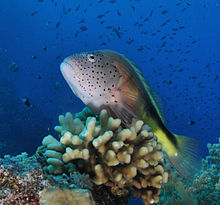
Coral stock habitat
Small, riffgebundene coral fish such as damselfish , blennies or Korallengrundeln often rely on bush-shaped coral to protect and defend them against predators. Large ramified hard coral sticks are often surrounded by a red cloud of anthias , or a green-blue or black-and-white cloud of the damselfish genera Chromis or Dascyllus . When a predator or a diver approaches, the school of fish, often numbering several hundred heads, disappears between the coral branches.
Exposed coral sticks serve as a hide for the tufted perch , from which they lurk for small prey fish and crustaceans. The fish fertilize their native coral stock through their excretions, which receives additional dissolved organic substances in the normally extremely nutrient-poor water of the coral reef.
A multitude of crustaceans live between the branches of many corals , including porcelain crabs , which also defend the corals against predators. Gall crabs (Cryptochiridae) live in special coral galls formed by the coral . In addition, symbiotic tube worms and burrs are known. These symbioses have not yet been adequately investigated, and it is not always certain whether and how the partners benefit from one another.
Predators
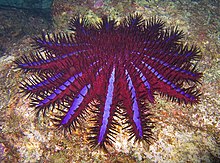
Hard corals are eaten by parrot fish , butterfly fish and pallet spines. While the butterfly fish and pallet spines only eat coral polyps one at a time and do not damage the skeleton, the parrot fish grate the coral surface with their beak-like teeth and the living tissue and the top layer of the skeleton. Healthy coral sticks overgrow the bare spots again in a short time.
In addition, the small, nocturnal snails of the Drupella and Coralliophila genera feed exclusively on coral polyps.
In the Great Barrier Reef , the coral-eating crown- of- thorns sea star ( Acanthaster planci ) multiplies from time to time . It is assumed that the larvae of the starfish have better chances of growth and survival due to increasing eutrophication . Different types of pillow starfish also eat stony coral polyps.
Boring organisms

A large number of organisms burrow into the coral skeleton by chemical or mechanical means to protect themselves from enemies. The most important are the drilling sponges , mostly of the genus Cliona , which create an extensive tunnel system of millimeter-wide corridors in the skeleton and which line the corridors with their tissue. From the outside, only the millimeter-sized green, yellow or red lined openings can be seen through which the water flows in and out. Drilling sponges can damage a coral skeleton so badly that it breaks. Other boring animals are mussels , especially the sea dates ( Lithophaga ) and the genus Gastrochaena , the ingrown giant clam ( Tridacna crocea ), injection worms , featherworms , calcareous tubeworms and sea urchins . Algae from the groups of green and red algae as well as cyanobacteria live in every coral skeleton and probably create cavities with the help of CO 2 from their breathing. The entire bioerosion caused by boring organisms contributes more to the destruction of coral reefs than mechanical damage from waves, surf and storms.
reproduction
Sexual reproduction
During sexual reproduction, the coral polyps spawn, often controlled by the phases of the moon . Hard corals are, depending on the species, hermaphrodite or separate sexes. The former release egg cells and sperm at different times in order to avoid self-fertilization.
In coral species with internal fertilization, the coral polyps only release the sperm cells, and the egg cells are fertilized in the mother animal. Finished planula larvae will then be released at a later point in time . However, the greatest number of coral species multiply through external fertilization. The coral polyps release sperm and egg cells at the same time. The fertilization, favored by the mass of the released germ cells, then takes place in free water. The fertilized egg cells develop into planula larvae, which float freely in the water for a few days, at most six weeks, and then settle in suitable locations. From the bilaterally symmetrical planula larva that has attached itself, a radially symmetrical polyp develops , which forms a skeleton, divides further and thus forms the basis of a new colony.
On the coast of Australia , the mass spawning of the corals is followed by a plankton bloom . Carnivorous zooplankton such as crustaceans and arrowworms reproduce en masse because of the oversupply of food and in turn lure the plankton-eating whale sharks to the coast.
Single-sex reproduction
Another possibility is the formation of planula larvae through parthenogenesis (virgin generation) in the gastric space. Like the larvae that emerged from sexual reproduction, the planula larvae must find a suitable substrate for settlement.
Asexual reproduction
If a coral colony breaks e.g. B. by waves, the fragments, if they are driven to a favorable settlement site, have the ability to grow further and to form a new colony. This form of reproduction occurs especially in the branchy growing antler corals of the genus Acropora . These species are usually very fast-growing. Saltwater aquarists use this possibility to artificially reproduce hard corals.
Other possibilities for asexual reproduction are the expulsion of polyps and the production of anthocauli. When polyps are expatriated, some polyps detach themselves from the coral hive without a skeleton, allow themselves to be drifted, settle in a favorable location again and form a new colony. Polyp expatriation is particularly common in the genus Pocillopora . Fungal corals (Fungiidae) form small daughter polyps called anthocauli at their base, which also form a skeleton early on and break off from the mother polyp after a while. These forms of asexual reproduction result in clones of the mother colony.
Tribal history
There are two different theories about the origin of hard corals. On the one hand, an ancestry from the Rugosa , mainly solitary corals from the Paleozoic, is assumed. The structure of the rugose skeleton from calcite and the completely different structure of the septa speak against this . In addition, the rugoses disappeared at the end of the Permian , while the hard corals only appeared in the Middle Triassic . In the Lower Triassic there is no fossil reef-forming Hexacorallia. Alternatively, there is a hypothesis about a non-skeletal and therefore not fossilized ancestor from the relationship of the sea anemones . The hard corals have not been proven to be monophyletic .
About 5000 species of fossil hard corals are known. They appeared after the previous main reef builders, the tabular corals (Tabulata) and the rugosa in Upper Perm, had died out. At first they only formed small reefs, mostly less than three meters high, in deeper water. This suggests that they were not yet in symbiosis with zooxanthellae. This community probably only emerged in the Upper Triassic or early Jurassic , when the reefs grew larger and more than 20 species were involved in reef formation. In the Jura, the Caryophylliina appeared , which include many solitary species and with Favia also a genus that is still alive today. The cold-water corals Oculina and Madrepora appeared in the Lower Cretaceous . The Dendrophylliina and the Acroporidae have been around since the Upper Cretaceous. They have a very light skeleton, grow the fastest and today make up about 40% of the coral fauna. The genera Acropora , Galaxea , Fungia , Pocillopora and Seriatopora were added in the course of the Tertiary . At the beginning of the Miocene , 23 million years ago, there was a great wave of extinction among the hard corals. Most of today's genera originated in the last 15 million years.
See also: Corals of the Swabian Alb
Systematics
External system
Hard corals belong to the cnidarians (Cnidaria) and there to the flower animals (Anthozoa), which differ from all other cnidarians, among other things, in that they never have a medusa stage . Within the flower animals they belong to the Hexacorallia , which are also called six- ray flower animals , and to which also the sea anemones (Actiniaria), the disc anemones (Corallimorpharia), the crust anemones (Zoanthidea) and the cylinder roses (Ceriantharia ) due to the number of their tentacles and other characteristics ) and the black corals (Antipatharia). Because of a large number of similarities in the anatomy of the polyps, the disc anemones are considered to be the group most closely related to the hard corals and are regarded as their sister group.
The following cladogram shows the likely internal systematics of the Hexacorallia:
| Hexacorallia |
|
||||||||||||||||||||||||
|
|
Internal system


The hard corals are now divided into 25 families with around 1490 described species. The classification is based on morphological features. Originally over 2500 species were described, but after revisions many were recognized as local varieties of already known species. The system shown here shows the valid families according to a recent publication:
- Order hard corals (Scleractinia bourne, 1900)
- Family Acroporidae Verrill, 1902
- Family Agariciidae Gray, 1847
- Family Anthemiphylliidae Vaughan, 1907
- Family Astrocoeniidae Koby, 1890
- Family Caryophylliidae Gray, 1846
- Family Dendrophylliidae Gray, 1847
- Family Euphylliidae Alloiteau, 1952
- Family Faviidae Gregory, 1900
- Flabellidae Bourne family , 1905
- Fungiacyathidae Chevalier family , 1987
- Family Fungiidae Dana, 1846
- Gardineriidae Stolarski family , 1996
- Family Guyniidae Hickson, 1910
- Family Meandrinidae Gray, 1847
- Family Merulinidae Verrill, 1866
- Micrabaciidae family Vaughan, 1905
- Mussidae Ortmann family , 1890
- Family Oculinidae Gray, 1847
- Family Pectiniidae Vaughan & Wells, 1943
- Family Pocilloporidae Gray, 1842
- Family Poritidae Gray, 1842
- Family Rhizangiidae d'Orbigny, 1851
- Siderastreidae family Vaughan & Wells, 1943
- Family Trachyphylliidae Verrill, 1901
- Turbinoliidae family Milne-Edwards & Haime, 1848
In the meantime there are first approaches to a phylogenetic systematics of the hard corals. It turned out that, in addition to a group of basal hard corals (Gardineriidae and Micrabaciidae), there are two previously unnamed main clades , which are temporarily referred to as complex and robust clades .
The complex clade includes the Acroporidae, the Agariciidae, Poritidae, Dendrophylliidae, Flabellidae, Turbinoliidae and Fungiacyathidae, as well as individual representatives of six other traditional families, the remaining genera of which belong to the robust hard corals. The robust hard corals form a monophyletic clade that has its roots within the family Agariciidae. The robust clade includes the Pocilloporidae and Fungiidae as monophyletic taxa, as well as representatives of the Anthemiphyllidae, the Stenocyathidae, Faviidae, Mussidae, Merulinidae, Rhizangiidae, Pectiniidae and Trachyphylliidae. The families Astrocoeniidae, Siderastreidae, Oculinidae, Meandrinidae, Euphylliidae and Caryophylliidae have representatives within the complex and robust corals and are therefore not monophyletic.
Most families, most of which include azooxanthellate deep-sea corals, are monophyletic, while most families of reef-building, tropical shallow-water corals are polyphyletic . The only exceptions are the families Acroporidae, Poritidae, Pocilloporidae, and Fungiidae.
In the crown group of robust corals a clade of Atlantic corals can be made out, which is composed of representatives of the Mussidae and the Faviidae. Sister group of this clade is an Indo-Pacific clade with the genera Mussidae, Faviidae, Merulinidae, Pectiniidae and Trachyphylliidae .
The following simplified cladogram shows the most important groups and their relationships:
| Hard corals |
|
|||||||||||||||||||||||||||||||||||||||||||||||||||||||||||||||||||||
|
|
Coral diseases
Coral bleaching
As coral bleaching is the phenomenon that stony corals under stress their zooxanthellae produce and can die afterwards. The corals lose their color as the brownish tones in particular come from the symbiotic algae in the skin. In 1988, at a coral reef symposium in Townsville , Australia, the global scale of the problem was first raised. The bleaching of corals has also been observed before, e.g. B. after heavy rain and the associated fresh water input or after heavy low water. The phenomenon only ever occurred locally. Global coral death is now associated with the increased temperature of surface water as a result of global warming . The most severe coral bleaching occurred in 1998 during an El Niño in the western Pacific and Indian Oceans . For months the temperatures were 1 to 3 ° C above the long-term average. The Maldives lost 98% of the near-surface coral fauna.
The robust corals are less sensitive to global warming and are less affected by coral bleaching than the complex corals.
Black band disease
The coral disease, described as Black Band Disease , occurs primarily in the Caribbean and was first recorded on the coast of Belize in the early 1970s . Characteristic is a black-purple band that slowly crawls over the living tissue of the coral, decomposing the tissue and leaving a bared, dead coral skeleton behind. The dead skeleton is quickly colonized by algae. Various unicellular microorganisms were found in the volume, such as the cyanobacteria Phormidium corallyticum , fungi, and other heterotrophic gram-negative , sulfate- reducing and sulfur- oxidizing bacteria. The bacterial flora is supposed to create a microenvironment that leads to the death of the coral tissue. To date, the Black Band Disease occurs only sporadically in the Indo-Pacific.
White pox disease
Scientists have now shown that the bacterium Serratia marcescens in stony corals the type elkhorn coral called White pox disease , English White pox disease triggers. Genetic tests and laboratory tests have shown that this germ, which is deadly for corals, does not come from other animals, but from sewage from humans.
Danger from humans
Today, hard corals are endangered by anthropogenic influences on many species. Due to global warming, there are more and more times when the temperature of the surface water is 30 ° C or higher, so that more coral bleaching occurs. In addition, hard corals and other inhabitants of the coral reefs are endangered by sewage from industry and agriculture , by fishing with dynamite and cyanide . In the Maldives, coral limestone is used as a building material for buildings and in road construction. In Indonesia, the slaked lime that is necessary to enjoy the betel nut is often obtained from coral lime. The tourist development of the reefs leads to direct destruction by the anchoring of yachts and excursion boats on the reefs and by careless snorkelers and divers.
Living stony corals are still being collected for marine aquariums . This is especially a problem with rare, massive, large polyp species that cannot be propagated by simple fragmentation. Some particularly colorful and sought-after species can no longer be found in many reefs.
In the future, ocean acidification will become a major problem for hard corals and other calcareous skeleton-forming organisms as the falling pH hampers skeletal formation.
Sources and further information
Sources cited
Most of the information in this article is taken from the sources given under literature, and the following sources are also cited:
- ↑ SA Fossa, AJ Nilsen: Coral reef aquarium. Volume 4, 1995, p. 295.
- ^ AJ Nilsen: Research in the Great Barrier Reef. In: Coral. Marine aquarium specialist magazine, No. 42, 2006/2007, pp. 46–49.
- ↑ Bernhard Ziegler: Introduction to Paleobiology. Part 2: Special paleontology, protists, sponges and coelenterates, molluscs. Schweizerbart'sche Verlagbuchhandlung, 1983, ISBN 3-510-65036-0 .
- ↑ Steven M. Stanley: Historical Geology: An Introduction to the History of the Earth and Life. Spektrum, Akad. Verlag, Heidelberg / Berlin / Oxford 1994, ISBN 3-86025-153-8 , p. 431.
- ↑ a b c d M. V. Kitahara, SD Cairns, J. Stolarski, D. Blair, DJ Miller: A Comprehensive Phylogenetic Analysis of the Scleractinia (Cnidaria, Anthozoa) Based on Mitochondrial CO1 Sequence Data. In: PLoS ONE. 5 (7) 2010, p. E11490. doi: 10.1371 / journal.pone.0011490
- Jump up ↑ Marymegan Daly, Mercer R. Brugler, Paulyn Cartwright, Allen G. Collin, Michael N. Dawson, Daphne G. Fautin, Scott C. France, Catherine S. McFadden, Dennis M. Opresko, Estefania Rodriguez, Sandra L. Romano, Joel L. Stake: The phylum Cnidaria: A review of phylogenetic patterns and diversity 300 years after Linnaeus. In: Zootaka. 1668, Wellington 2007 ISSN 1175-5326 , pp. 127-182. (Abstract - PDF)
- ^ SL Romano, SD Cairns: Molecular Phylogenetic Hypotheses for The Evolution of Scleractinian Corals. In: Bulletin of Marine Science. Volume 67, Number 3, November 2000, pp. 1043-1068.
- ↑ Jarosloaw Stolarski, Ewa Roniewicz: Towards a new synthesis of evolutionary relationships and classification of scleractinia. In: Journal of Paleontology. Nov 2001.
- ↑ H. Schumacher, K. u. W. Loch, WR Lake. The pale of the corals. In: Biology in Our Time. 3/2005, pp. 186-191.
- ↑ Hua Ying, Ira Cooke, Susanne Sprungala, Weiwen Wang, David C. Hayward, Yurong Tang, Gavin Huttley, Eldon E. Ball, Sylvain Forêt, David J. Miller. Comparative genomics reveals the distinct evolutionary trajectories of the robust and complex coral lineages. Genome Biology, 2018; 19 (1) DOI: 10.1186 / s13059-018-1552-8
- ↑ D. Combosch, H. Schumacher: Biotic coral diseases . In: Biology in Our Time. 3/2005, pp. 178-184.
- ↑ Kathryn L. Patterson et al.: The etiology of white pox, a lethal disease of the Caribbean elkhorn coral, Acropora palmata. In: Proc Natl Acad Sci. US A. Vol. 99, No. 13, June 25, 2002, pp. 8725-8730, PMID 12077296 .
- ↑ Kathryn Patterson Sutherland et al: Human Pathogen Shown to Cause Disease in the Threatened Eklhorn Coral Acropora palmata. In: PLoS ONE. Volume 6, No. 8, p. E23468, doi: 10.1371 / journal.pone.0023468 .
- ↑ H. Schumacher: Coral reefs are threatened worldwide. In: Biology of the Seas. Spektrum Akad. Verlag, 1991, ISBN 3-89330-753-2 .
- ↑ Scientific Advisory Council of the Federal Government on Global Change: The Future of the Seas - Too Warm, Too High, Too Sour ( Memento of the original from August 11, 2013 in the Internet Archive ) Info: The archive link was inserted automatically and not yet checked. Please check the original and archive link according to the instructions and then remove this notice. . Special report , Berlin 2006, ISBN 3-936191-13-1 . (PDF, 3.5 MB).
literature
- Helmut Schuhmacher: Coral reefs. BLV Verlagsgesellschaft, Munich 1988, ISBN 3-405-13614-8 .
- Yossi Loya, Ramy Klein: The world of corals. Jahr Verlag, Hamburg 1998, ISBN 3-86132-226-9 .
- Julian jump: corals. Dähne Verlag, 2000, ISBN 3-921684-87-0 .
- Svein A. Fossa, Alf Jacob Nilsen: Coral reef aquarium. Volume 4, Schmettkamp Verlag, 1995, ISBN 3-928819-05-4 .
- J. Sprung, JC Delbeek: The reef aquarium. Volume 1, 1994, ISBN 1-883693-17-9 .
- Hans A. Baensch , Robert A. Patzner (ed.): Sea water atlas. Volumes 2, 4 + 5, Mergus-Verlag, Melle, DNB 551910011 .
- Rainer Kaiser: Lower animals of tropical and cold seas in the aquarium . Ulmer, Stuttgart 1991, ISBN 3-8001-7222-4 .
- TF Goreau, NI Goreau, TJ Goreau: corals and coral reefs. In: Biology of the Seas. Spektrum Akad. Verlag, Berlin et al. 1991, ISBN 3-89330-753-2 , p.
further reading
- Key to Corals in Corals of the World by Veron JEN, publisher: Australian Institute of Marine Science December 2000, 1382 pages, ISBN 978-0-642-32236-4
- Stephen Cairns, Marcelo Kitahara: An illustrated key to the genera and subgenera of the Recent azooxanthellate Scleractinia (Cnidaria, Anthozoa), with an attached glossary. In: ZooKeys . 227 (2012), pp. 1-47, doi: 10.3897 / zookeys.227.3612 .
- JEN Veron : Corals in Space and Time: The Biogeography and Evolution of the Scleractinia. Cornell University Press, 1995, ISBN 0-8014-8263-1 .
Web links
- Romano, Sandra L. and Stephen D. Cairns. 2002. Scleractinia. Stony star corals. Version 28 October 2002 (under construction). The Tree of Life Web Project
- Classification of Scleractinian (Stony) Corals
- Online description of reef building corals Corals of the World - All Factsheets
- Small polyp stony corals in the marine lexicon
- Large polyp hard corals in the marine lexicon



